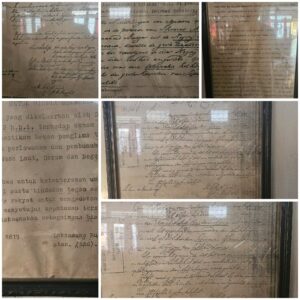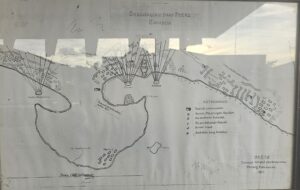Date and Place:
Ambon (Amboina), December 1817 – February 1818
Issuing Authorities:
– Raad van Justitie der Moluccen (Council of Justice of the Moluccas)
– Vice Admiral A.A. Buijskes, Commissioner-General of the Dutch East Indies
Subject:
Thomas Matulessy, known as Kapitan Pattimura, from Haria on the island of Saparua.
Leader of the 1817 uprising against the re-establishment of Dutch colonial rule in the Moluccas.
Documents Overview (picture see below)
These documents record the arrest, trial, sentencing, and execution of Pattimura and several of his key associates.
- Verdict of the Council of Justice – 12 December 1817
The colonial court found Thomas Matulessy guilty as:
- Leader of rebellion (oproermaker)
• Commander of insurgent forces (aanvoerder der muitelingen)
• Responsible for the killings that occurred during the capture of Fort Duurstede and related actions on Haruku, Nusa Laut, Seram, and in the villages of Cekith and Lima.
Sentence: death.
- Ratification of Sentence – 13 December 1817
Commissioner-General Buijskes approved the judgment and ordered the execution to take place in Ambon.
He stated that the punishment was necessary to restore “public order” and deter further rebellion.
- Additional Execution Decree
The execution order specified that after death, the bodies of Pattimura and several associates were to be:
“placed in iron cages and hung outside the city walls, so that the air and the birds shall consume the flesh, and the bones turn to dust, as a warning to others.”
This reflects a colonial practice intended to display state authority and discourage further resistance.
- Follow-up Correspondence – February 1818
Administrative notes confirmed that Matulessy was recognized among the local population as Kapitan Pattimura, and that he served as both symbolic and strategic leader of the uprising.
Historical Context
The uprising occurred shortly after the Dutch repossessed the Moluccas from the British in 1816.
Local communities opposed:
- The restoration of Dutch monopoly control over cloves
• Forced delivery quotas and corvée labour
• The reduction of village and regional autonomy
Pattimura’s forces captured Fort Duurstede and expelled Dutch authority from Saparua for several months. Dutch reinforcements eventually defeated the resistance. Pattimura was executed on 16 December 1817.
Historical Significance
These records present the Dutch colonial legal perspective, defining Pattimura as a rebel and criminal.
In Indonesian historical memory, however, Pattimura is honoured as:
- A defender of indigenous sovereignty
• A symbol of collective resistance against colonial domination
• One of the early figures in the long struggle toward independence
His legacy is visible in:
- Monuments across Maluku
• Street and district names throughout Indonesia
• Universitas Pattimura in Ambon, the regional university named in his honour
The case illustrates how early anti-colonial resistance in the archipelago predated the 20th-century national awakening, revealing deep historical roots of Indonesian independence.

Figure 1 Documents on display at the Pattimura Museum in Saparua. Text read and summarised by AI.

Figure 2 The The Dutch navy battle recapturing Fort Duurstede which had been taken by Pattimuru.
Tracing Dutch Batavia: From the Old City to Buitenzorg
Exploring Java’s Colonial Legacy: Bandung, Cimahi, Yogyakarta and Surabaya
The Moluccas: Islands of Spice, Memory and Continuity
The Long Road to Independence: From Colonial Resistance to the Birth of Indonesia